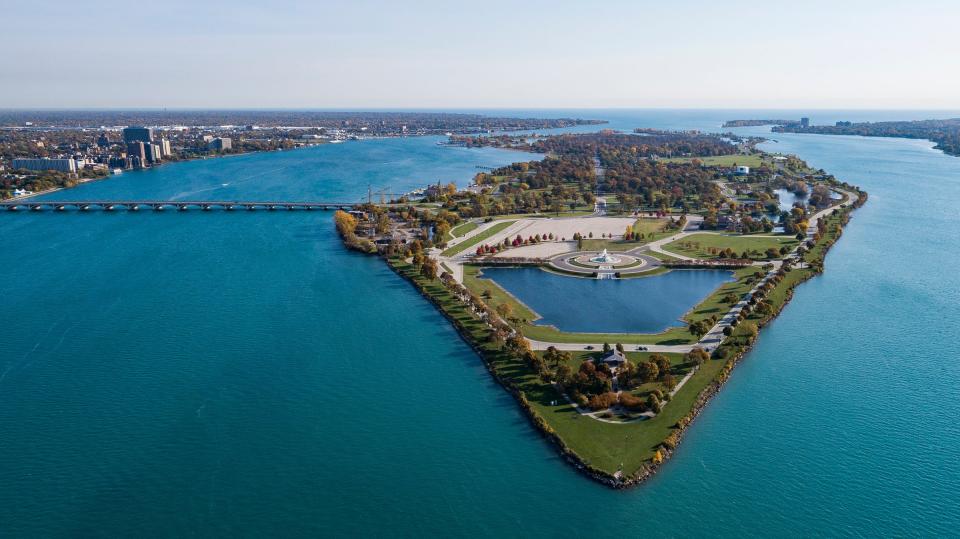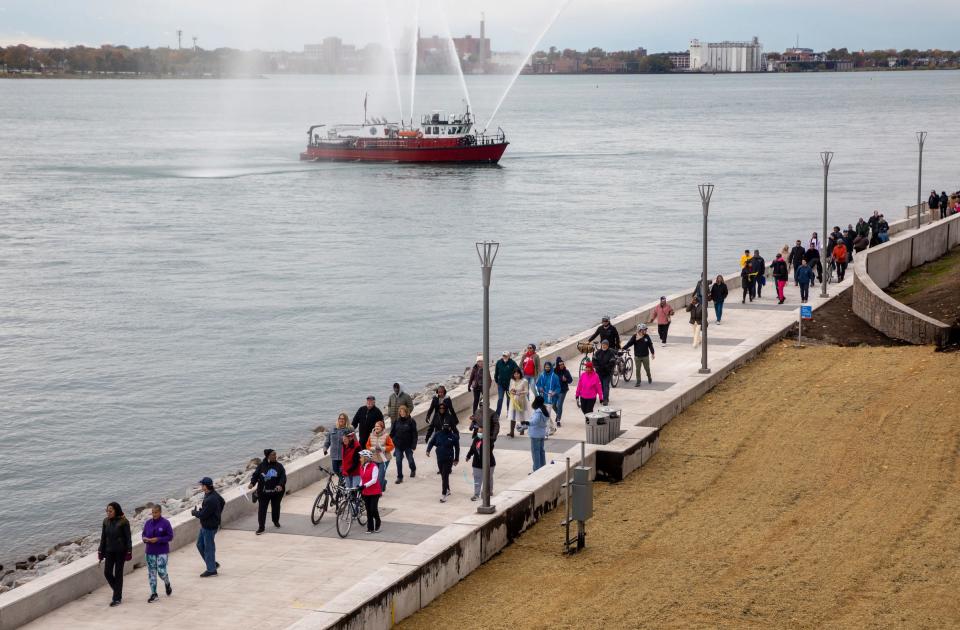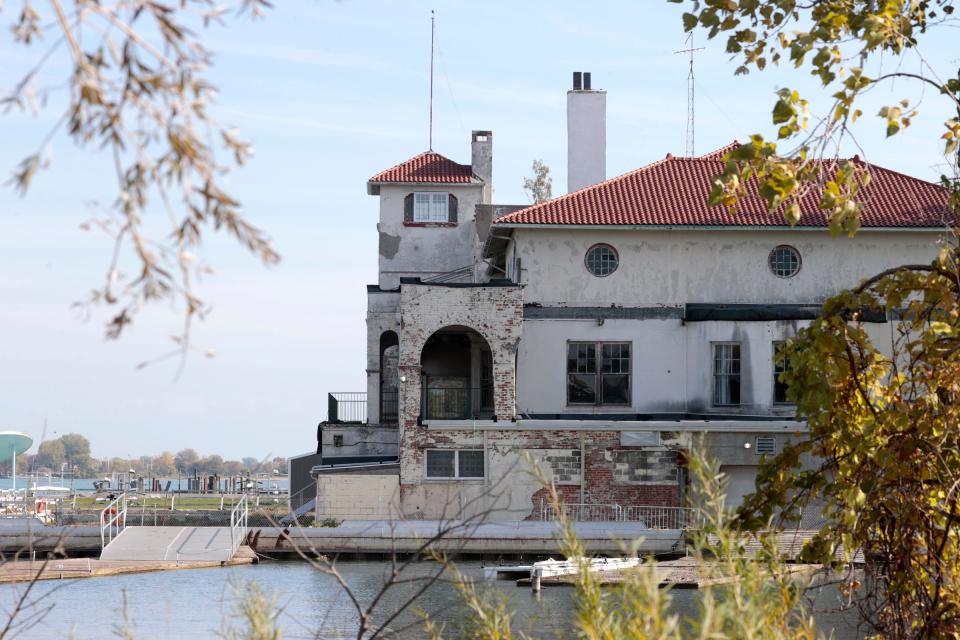Detroit needed help to save Belle Isle: 5 other gems the city handed over for improvements
Like many Detroiters, generations of Donna Givens’ family grew up visiting Belle Isle.
It was the spot for picnics, the beach, reunions and all sorts of recreational activities. Her parents and grandparents would camp out on the island on hot summer nights when it felt too stuffy inside. But since the state began managing the park 10 years ago, heavier enforcement has prevented people from staying after hours or has turned folks away due to overcrowding of vehicles.
“I was never really in favor of giving the power away, despite the need for investment in the park. If there was going to be a toll taken in the park, then it should’ve gone to Detroit’s budget so Detroit could prioritize how to spend the funds,” said Givens, president of the Eastside Community Network. “I think it should be turned back to the city … to give permission or power to people, many of whom are not Detroiters … is a slap in the face to Detroiters.”

But that need for investment — the state has spent $115 million and counting since taking over — was something pre-bankruptcy Detroit city government couldn't swing, and not just for Belle Isle. The park is but one example of the city relinquishing control of an amenity or partnering with other public entities or nongovernmental organizations to make improvements. Among the examples:
Eastern Market: The market, which the Detroit Historical Society says is "the largest open-air flowerbed market in the United States and the largest historic public market district in the United States," in 2006 was turned over to the nonprofit Eastern Market Corp. Since then, sheds have been restored and enclosed and a range of activities and initiatives have boosted the beloved destination.
Detroit RiverWalk: The riverfront, which at the turn of the century was walkable only from about the Renassaince Center to the now-demolished Joe Louis Arena, was developed by the nonprofit Detroit Riverfront Conservancy, formed in 2003. The RiverWalk now extends from the Riverfront apartments to Gabriel Richard Park at the foot of the MacArthur Bridge to Belle Isle, with a western extension under construction with the Ralph C. Wilson Centennial Park.
Detroit Institute of Art: With the art collection under threat of sale as the city went through the largest municipal bankruptcy in U.S. history in 2013, the museum was given a stable funding source through a regional tax that grants free access to residents of Wayne, Oakland and Macomb counties.
Huntington Place: What was then called Cobo Center, a famed Detroit venue, was turning shabby, with significant infrastructure issues when it was turned over to a regional authority in 2009. Now called Huntington Place, the convention center has been revived by a nearly $300 million expansion.
Campus Martius: At the turn of the century, only the Soldiers and Sailors Monument, surrounded by traffic, stood at what once was the hub of Detroit government and commerce. The Downtown Detroit Partnership opened Campus Martius Park in 2004 and today is home to the city's Christmas tree each year, winter ice skating, summertime concerts and movie nights, along with a restaurant and children's play area.
Outside investments in these assets, along with cultural institutions and small businesses, enhanced the city and experiences for visitors, and the more partners continue to invest, the better things will be, said Chris Moyer, spokesman at Visit Detroit.
'Centerpiece of why Detroit's such a great place to visit'
"It's also important to remember (Belle Isle) has been a jewel for the city of Detroit for a long time," Moyer said.
"Further state investment has only helped bring some of the beauty even more to the surface," he said, adding: "Continued investment in Belle Isle, while making sure that it is accessible for all Detroiters and all southeast Michiganders and visitors, everybody in the state, and across the country, across the world, is only going to continue to make it this absolute centerpiece of why Detroit's such a great place to visit."
Moyer touted the RiverWalk as one of the top public spaces in the country; Eastern Market as one of the oldest markets, which continues to grow and expand, and Campus Martius all as economic engines that would not have been the same 20 years ago.

"I always want to push back on the idea that Detroit has some great comeback story, because it diminishes what people were doing in the '70s, '80s, '90s and 2000s. There were challenges then, and there are challenges now. The city is in a much better place than it was a few decades ago. But there were always great things happening," Moyer said. "This has made our community a better place to live, work, play and visit.
Givens agrees that state stewardship of Belle Isle has provided upgrades and polished exteriors on the island, but she said that since public spaces have taken on partners beyond the city, it sometimes feels like being outside is illegal due to curfews and enforcement.
In 2018, Givens said she was escorted off of Belle Isle by state police for being at the James Scott Fountain at 10 p.m. and shooed away outside of Parc restaurant on Campus Martius one night.
Belle Isle's many partnerships
Among these public amenities, Belle Isle operates with a constellation of partners.
The idea of handing control to the state was to relieve the city of expenses to preserve the park amid Detroit's bankruptcy. The city owns the park, but in 2014 agreed to lease it to the state for 30 years.
The Belle Isle Conservancy was formed in 2012 as a nonprofit intended to preserve the island and has invested $16 million since. The conservancy’s signature project was reviving the Belle Isle aquarium, but it also helped renovate Sunset Point, repair the James Scott Fountain and manage volunteers for cleanup efforts on the island’s land and waterways, said Maud Lyon, interim president of the conservancy.
A mix of public and private investments turned the island around after the early 2000s. Lyon cited a 2005 master plan that concluded Belle Isle required $300 million of improvements, including new lightbulbs, drainage upgrades, and properly maintained buildings and athletic fields.
“The city hasn’t had resources. Its Detroit parks in general didn’t have resources for some time. The people in the (parks) department decreased, you had less money, fewer staff. It’s not that the city didn’t want to take care of Belle Isle and other parks, it’s just that it literally lacked the resources to do so,” Lyon said.
The island has various organizations to help improve park amenities, including Friends of Detroit Rowing, the Detroit Zoological Society-run nature center, along with the Department of Natural Resources putting in resources to fix up amenities such as the James Scott Fountain and more recently, the casino.
“They’re doing a complete overhaul of it, which is desperately needed,” Lyon said.
More work ahead
Casino work includes roof tile replacements by the original manufacturer and elevator upgrades to ensure the space is compliant with the American Disabilities Act. The DNR has also dropped money into the recreational and athletic spaces, Lyon said, adding that they walked into a park with “deferred maintenance for decades.”
“The DNR, for the last 10 years, has been working to invest in historical features, roads, bridges, sidewalks and trails,” Lyon said, adding that the department has also invested in planning, including a mobility study to improve vehicle, pedestrian and cyclist movement on Belle Isle.
Funding stems from a variety of sources: mostly public investment and some from private partners. Ralph C. Wilson Foundation invested in the Iron Belle trail, which is designed to ultimately connect Belle Isle and the Upper Peninsula. Lyon called the park’s operating arrangements “fairly unusual” compared with other cities.
“It’s the only one where a state took on a discrete part and said we can operate it. The state felt it could be helpful to Detroit,” Lyon said. “Usually, parks in major cities are run by the city or county. Having it run by the state was a solution that worked here … it really has improved a lot in the last 10 years.”
'It's cleaned up now'
Dennis Wojdyla, who grew up in Detroit playing sports at the island’s athletic shelter and remembers various sporting and entertainment activities taking place, thought the island has changed.
“Everything I’ve noticed since they’ve taken over is good. Grass is cut, the bathrooms are open, the bathrooms are clean. There’s enough law enforcement, not that it was a dangerous place … but there were drug sales. It’s cleaned up now. They’ve made a lot of improvements. They spent a lot of money,” Wojdyla said. "The only knock is ... they should probably put that concrete slab back to green space," referring to the lot near the fountain.
Belle Isle was the party place during Wojdyla’s teenage years. He and his high school friends would throw parties there in 1968-69. At his 50-year class reunion, he and his friends noticed “night and day” changes since the 1990s, he added.
Wojdyla is on the board of Friends of Detroit Rowing, a group that provides competitive and recreational programs for rowers, and he has been working with the DNR to build a temporary structure while officials decide on the future of the Belle Isle Boat House.
“The Boat House is up in the air,” Wojdyla said. “What we think should be done is some of it should come down, and the rest of it restored, and make it a welcome center to Belle Isle. It’d be a great place for a museum. We had many Olympians and U.S. National team rowers. You could have a hall of fame. It could be a meeting space. Before we got vacated from the building, we had a wedding almost every weekend.”

Detroit City Council passed a symbolic resolution this month calling for its preservation using American Rescue Plan Act funds.
Resident advocates free access for Detroiters
Still, Detroit residents should be given access, said Givens, who often bikes or walks to the park to avoid being turned away. Entry booths on the island can create a perception that the park is gated and exclusive, she said, and it’s unclear when guards actually collect tolls. Sometimes, nobody is in the booth.
“It feels like part of a park system that’s become inaccessible at times. Hot summer days have always been attractive,” Givens said. “It feels like privatization.”

Detroiters and residents in Oakland, Wayne and Macomb counties can enter places like the Detroit Institute of Arts without cost because of a tri-county tax millage funding the museum. Lyon added that since the DNR runs the park, drivers can enter freely with an annual recreational passport on their license plates for $14 a year, which provides access to all state parks. Pedestrians and cyclists do not have to pay.
"Belle Isle is such an icon of Detroit. Everybody has memories of going there when they were a kid. It absolutely is a part of Detroit and the region that everybody can identify with," Lyon said. "It really has improved a lot in the last 10 years."
Dana Afana is the Detroit city hall reporter for the Free Press. Contact Dana: dafana@freepress.com. Follow her on X: @DanaAfana.
This article originally appeared on Detroit Free Press: Partnerships, alliances changed Detroit's iconic Belle Isle Park

